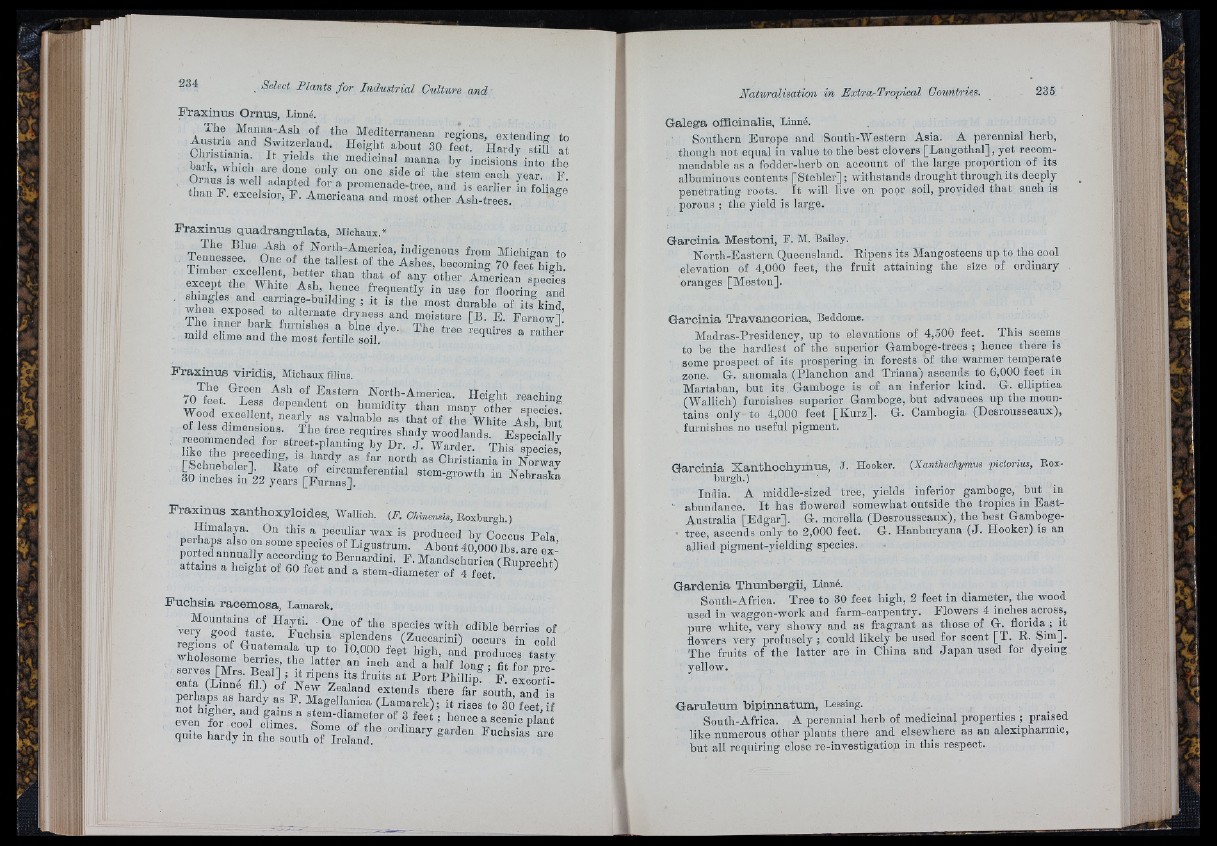
Fraximis Ornus, Linné.
j-lie Manna-Asli of the Mediterranean regions, extending to
Austria and Switzerland. Height about 30 feet. Hardy still a t
b a îï by incisions into tbe
baik, «hicli are done only on one side of the stem eacli year. F
tha 1 F adapted for a promenade-tree, and is earlier in foliage
than F. excelsior, F . Americana and most other Ash-trees.
Fraxinus quadrangulata, Michaux.»
The Blue Ash of North-America, indigenous from Michigan to
Tennessee. One of the tallest of the Ashfs, becoming 70 feet “ gli
e x i r t l i r IVhY A*?"’ 1*^'“ except the B hite Ash, lience fre‘q uently in nse ^fo“r® ”fl<o=oanr insgp ecaineds
. shingles and carnage-building ; it is the most durable of its kind
when exposed to alternate dryness and moisture [B. E. F e rn ow l’
Ti e inner bark furnishes a blue dye. The tree requires a rather
mild clime and the most fertile soil.
Fraxinus viridis, Michaux filius.
Eastern North-America. Height reaching
^ feet. Less dependent on humidity than many other species
Wood excellent, nearly as valuable as th a t of the White Ash but
of less dimensions. The tree requires shady w o o d la n r EÎpÎc’ia Ïv
reeomm®nded for street-planting by Dr. J . Warder. This species
rS c h u e L ie r2 as far north as Christiania in Norway
Fraxinus xanthoxyloides, Wallich. (F. O/Aensis, Roxburgh )
Fuchsia racemosa^ Lamarck.
Mountains of Hayti. One of the species with edible berries of
r e u L n ? c r 7 ‘ splendens (Zuccarini) occurs in cold
rep o n s of Guatemala up to 10,000 fept higji, and produces tastv
wholesome berries, the latter an inch and a half ion J fit f ^
Phillip. ’ F . exoortTa
(Lmne fll ) of New Zealand extends there far south and is
n i h k h i r i (Lamarck),- it rises to 30 feet, if
quite hardy in the south of Ireland. J-ucnsias are
Galega offlcinalis, Linné.
Sonthern Europe and South-Western Asia. A perennial herb,
though not equal in value to the best clovers [Langethal], yet reeommendable
as .a fodder-herb on account of the large proportion of its
albuminous contents [Stebler] ; withstands drought through its deeply
penetrating roots. I t will live on poor soil, provided th a t such is
porous ; the yield is large.
Garcinia Mestoni, F. M. Bailey.
North-Eastern Queensland. Ripens its Mangosteens up to the cool
elevation of 4,000 feet, the fruit attaining the size of ordinary
oranges [Meston].
Garcinia Travancorica, Beddome.
Madras-Presidency, up to elevations of 4,600 feet. This seems
to be the hardiest of the superior Gamboge-trees ; hence there is
some prospect of its prospering in forests of the warmer temperate
zone. G. anómala (Planchón and Triana) ascends to 6,000 feet in
Martaban, but i t s , Gamboge is of an inferior kind. G. elliptioa
(Wallich) furnishes superior Gamboge, but advances up the mountains
only to 4,000 feet [K u rz ]. G. Cambogia (Desrousseaux),
furnishes no useful pigment.
Garcinia Xanthochymus, J. Hooker. (Xanthochymus pictorius, Roxburgh.)
India. A middle-sized tree, yields inferior gamboge, but in
■ abundance. I t has flowered somewhat outside the tropics in E a st-
Australia [Edgar], G. morella (Desrousseaux), the best Gamboge-
tree, ascends only to 2,000 feet. G. Hanburyana (J . Hooker) is an
allied pigment-yielding species.
Gardenia Thuntaergii, Linné.
South-Africa. Tree to 80 feet high, 2 feet in diameter, the wood
used in waggon-work and farm-carpentry. Flowers 4 inches across,
pure white, very showy and as fragrant as those of G. florida ; it
■flowers very profusely ; could likely be used for scent [T . R. Sim].
The fruits of the latter are in China and Jap an used for dyeing
yellow.
Garuleum bipinnatum, Lessing.
South-Africa. A perennial herb of medicinal properties -, praised
like numerous other plants there and elsewhere as an alexipharmio,
but all requiring close re-investigation in this respect.
.